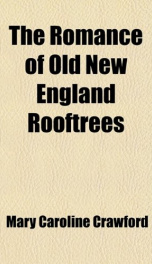social life in old new england

Purchase of this book includes free trial access to www.million-books.com where you can read more than a million books for free. This is an OCR edition with typos. Excerpt from book: was the unit of school management, however, and it was therefore only intermittently that education was dispensed in the rude little structure erected for the purpose. Thus, from the town meeting reports of one community, may be read: " 1786: Voted not to have schooling this winter. " 1787: Voted to raise the sum of £10 and divide it among the five school districts, each district to receive 40s. " 1789: No money appropriated for schools on account of building the meeting house. "1790: The building erected on the hill for a pest house was removed into the town street for a school house." The most cheerful things about these early school buildings was the color they were painted. Latterly, there has been an attempt to shatter one of our cherished New England traditions by asserting that this color was not red. But the weight of evidence is all on the other side; the " little red schoolhouse " remains. It was usually a small, one-room building this schoolhouse which was entered through a shed-like hallway in which wood was piled and where hats, coats, and dinner-pails were also stored. Sometimes wood was furnished by the parents, the child with a stingy father being then, by common consent, denied intimate re- O Klations with the fire. After the time of fireplaces a large square stove in the center of the room was the usual method of heating. From this a long pipe, suspended by chains, reached to the end of the building, where the chimney stood. Frequently this primitive heating-plant had to cope with the problem of raising the temperature from twelve below zero, when school opened, to a temperature favorable to " wrighting." The first seats in these little red schoolhouses were planks set on legs. These were sometimes taken out at noontime, turned bottom upw...
Info about the book
Author:
Series:
Unknown
ASIN:
155652322X
Rating:
3.5/5 (1)Your rating:
0/5
Languge:
English
Users who have this book
Users who want this book
What readers are saying
What do you think? Write your own comment on this book!
write a commentif you like social life in old new england try:
Do you want to exchange books? It’s EASY!
Get registered and find other users who want to give their favourite books to good hands!


